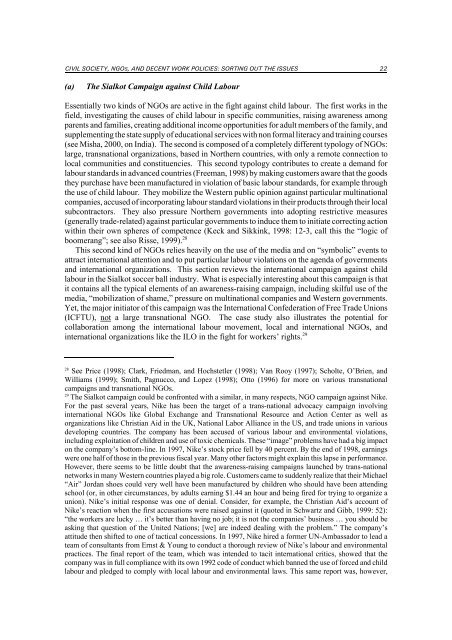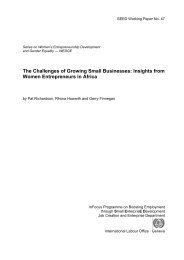Civil Society, NGOs, and Decent Work Policies: Sorting out the Issues
Civil Society, NGOs, and Decent Work Policies: Sorting out the Issues
Civil Society, NGOs, and Decent Work Policies: Sorting out the Issues
Create successful ePaper yourself
Turn your PDF publications into a flip-book with our unique Google optimized e-Paper software.
CIVIL SOCIETY, NGOS, AND DECENT WORK POLICIES: SORTING OUT THE ISSUES 22<br />
(a)<br />
The Sialkot Campaign against Child Labour<br />
Essentially two kinds of <strong>NGOs</strong> are active in <strong>the</strong> fight against child labour. The first works in <strong>the</strong><br />
field, investigating <strong>the</strong> causes of child labour in specific communities, raising awareness among<br />
parents <strong>and</strong> families, creating additional income opportunities for adult members of <strong>the</strong> family, <strong>and</strong><br />
supplementing <strong>the</strong> state supply of educational services with non formal literacy <strong>and</strong> training courses<br />
(see Misha, 2000, on India). The second is composed of a completely different typology of <strong>NGOs</strong>:<br />
large, transnational organizations, based in Nor<strong>the</strong>rn countries, with only a remote connection to<br />
local communities <strong>and</strong> constituencies. This second typology contributes to create a dem<strong>and</strong> for<br />
labour st<strong>and</strong>ards in advanced countries (Freeman, 1998) by making customers aware that <strong>the</strong> goods<br />
<strong>the</strong>y purchase have been manufactured in violation of basic labour st<strong>and</strong>ards, for example through<br />
<strong>the</strong> use of child labour. They mobilize <strong>the</strong> Western public opinion against particular multinational<br />
companies, accused of incorporating labour st<strong>and</strong>ard violations in <strong>the</strong>ir products through <strong>the</strong>ir local<br />
subcontractors. They also pressure Nor<strong>the</strong>rn governments into adopting restrictive measures<br />
(generally trade-related) against particular governments to induce <strong>the</strong>m to initiate correcting action<br />
within <strong>the</strong>ir own spheres of competence (Keck <strong>and</strong> Sikkink, 1998: 12-3, call this <strong>the</strong> “logic of<br />
boomerang”; see also Risse, 1999). 28<br />
This second kind of <strong>NGOs</strong> relies heavily on <strong>the</strong> use of <strong>the</strong> media <strong>and</strong> on “symbolic” events to<br />
attract international attention <strong>and</strong> to put particular labour violations on <strong>the</strong> agenda of governments<br />
<strong>and</strong> international organizations. This section reviews <strong>the</strong> international campaign against child<br />
labour in <strong>the</strong> Sialkot soccer ball industry. What is especially interesting ab<strong>out</strong> this campaign is that<br />
it contains all <strong>the</strong> typical elements of an awareness-raising campaign, including skilful use of <strong>the</strong><br />
media, “mobilization of shame,” pressure on multinational companies <strong>and</strong> Western governments.<br />
Yet, <strong>the</strong> major initiator of this campaign was <strong>the</strong> International Confederation of Free Trade Unions<br />
(ICFTU), not a large transnational NGO. The case study also illustrates <strong>the</strong> potential for<br />
collaboration among <strong>the</strong> international labour movement, local <strong>and</strong> international <strong>NGOs</strong>, <strong>and</strong><br />
international organizations like <strong>the</strong> ILO in <strong>the</strong> fight for workers’ rights. 29<br />
28<br />
See Price (1998); Clark, Friedman, <strong>and</strong> Hochstetler (1998); Van Rooy (1997); Scholte, O’Brien, <strong>and</strong><br />
Williams (1999); Smith, Pagnucco, <strong>and</strong> Lopez (1998); Otto (1996) for more on various transnational<br />
campaigns <strong>and</strong> transnational <strong>NGOs</strong>.<br />
29<br />
The Sialkot campaign could be confronted with a similar, in many respects, NGO campaign against Nike.<br />
For <strong>the</strong> past several years, Nike has been <strong>the</strong> target of a trans-national advocacy campaign involving<br />
international <strong>NGOs</strong> like Global Exchange <strong>and</strong> Transnational Resource <strong>and</strong> Action Center as well as<br />
organizations like Christian Aid in <strong>the</strong> UK, National Labor Alliance in <strong>the</strong> US, <strong>and</strong> trade unions in various<br />
developing countries. The company has been accused of various labour <strong>and</strong> environmental violations,<br />
including exploitation of children <strong>and</strong> use of toxic chemicals. These “image” problems have had a big impact<br />
on <strong>the</strong> company’s bottom-line. In 1997, Nike’s stock price fell by 40 percent. By <strong>the</strong> end of 1998, earnings<br />
were one half of those in <strong>the</strong> previous fiscal year. Many o<strong>the</strong>r factors might explain this lapse in performance.<br />
However, <strong>the</strong>re seems to be little doubt that <strong>the</strong> awareness-raising campaigns launched by trans-national<br />
networks in many Western countries played a big role. Customers came to suddenly realize that <strong>the</strong>ir Michael<br />
“Air” Jordan shoes could very well have been manufactured by children who should have been attending<br />
school (or, in o<strong>the</strong>r circumstances, by adults earning $1.44 an hour <strong>and</strong> being fired for trying to organize a<br />
union). Nike’s initial response was one of denial. Consider, for example, <strong>the</strong> Christian Aid’s account of<br />
Nike’s reaction when <strong>the</strong> first accusations were raised against it (quoted in Schwartz <strong>and</strong> Gibb, 1999: 52):<br />
“<strong>the</strong> workers are lucky … it’s better than having no job; it is not <strong>the</strong> companies’ business … you should be<br />
asking that question of <strong>the</strong> United Nations; [we] are indeed dealing with <strong>the</strong> problem.” The company’s<br />
attitude <strong>the</strong>n shifted to one of tactical concessions. In 1997, Nike hired a former UN-Ambassador to lead a<br />
team of consultants from Ernst & Young to conduct a thorough review of Nike’s labour <strong>and</strong> environmental<br />
practices. The final report of <strong>the</strong> team, which was intended to tacit international critics, showed that <strong>the</strong><br />
company was in full compliance with its own 1992 code of conduct which banned <strong>the</strong> use of forced <strong>and</strong> child<br />
labour <strong>and</strong> pledged to comply with local labour <strong>and</strong> environmental laws. This same report was, however,
















